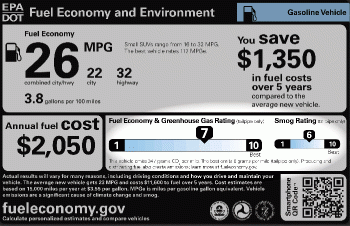Greenhouse Gas Versus Smog Forming Emissions
Why are there different ratings?

We rate these emissions separately because they represent different pollutants that affect different layers in our atmosphere.

Greenhouse Gas Emissions
- Greenhouse gases (GHGs) are emitted from the tailpipes of cars and trucks that combust fuel.
- Once GHGs are released, they can stay in the atmosphere for 100 years or more.
- GHGs act like a blanket around Earth, trapping energy in the atmosphere and causing it to warm. This can change Earth's climate, raise sea levels, and result in dangerous effects to human health and welfare, and to ecosystems.
- The effects are global.
Smog Forming Emissions
- Cars and trucks that combust fuel also emit smog forming emissions, such as nitrogen oxide, non-methane organic gases, carbon monoxide, particulate matter, and formaldehyde.
- These emissions are usually trapped close to the ground, and can form a brownish haze that pollutes our air, particularly over cities in the summertime.
- Smog can make it difficult for some people to breathe, triggering lung diseases such as asthma, emphysema, and chronic bronchitis.
- The effects are local, regional, and national.
The Good News...
- Vehicles are getting more efficient. The more efficient a vehicle, the fewer greenhouse gases it emits. Average new vehicle fuel economy has increased from 13 mpg in 1975 to 24 mpg today, and it is expected to rise to about 40 mpg in 2025. Visit our fuel economy trends page for more details on how much fuel efficiency is improving.
- Cars and trucks are 98-99% cleaner than they were in the late 1960s for smog-related pollutants, and they're getting cleaner every year. Visit our vehicle emissions page for more details on cleaner emissions standards for cars and trucks.
- No matter what size car or truck you need, you now have more efficient, cleaner options. Look for greenhouse gas and smog ratings on the window sticker, or at fueleconomy.gov.

For more information, visit EPA's sites on:
